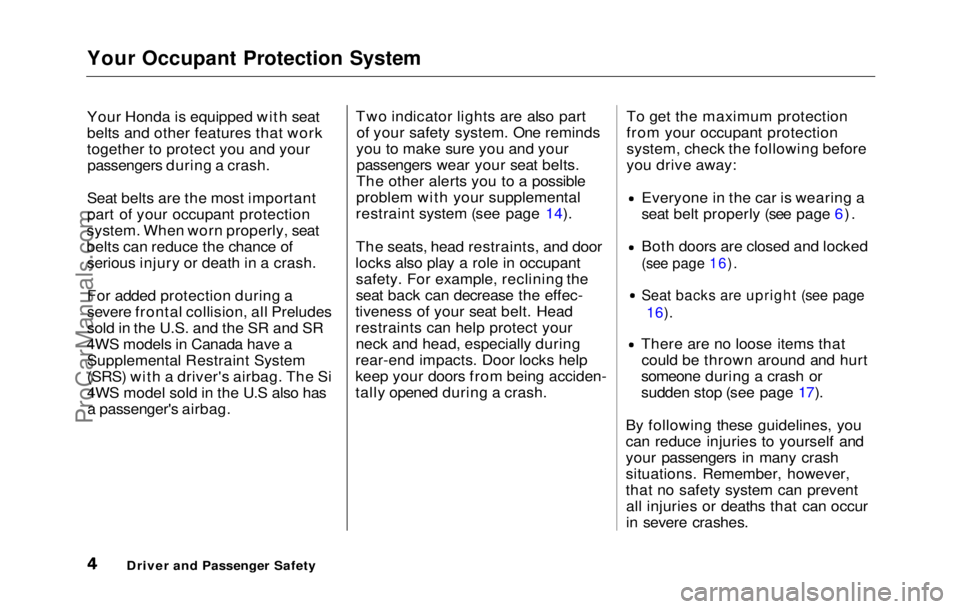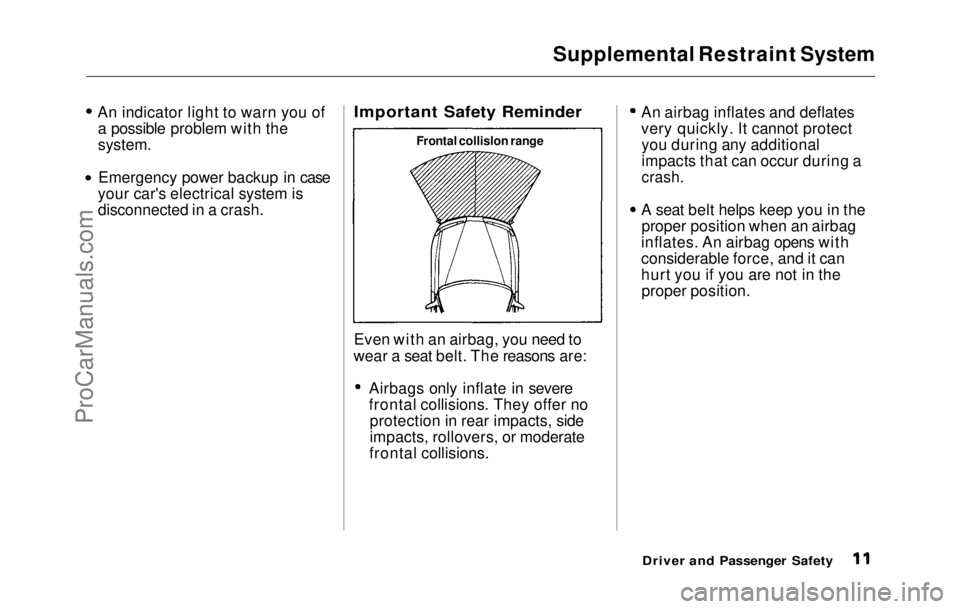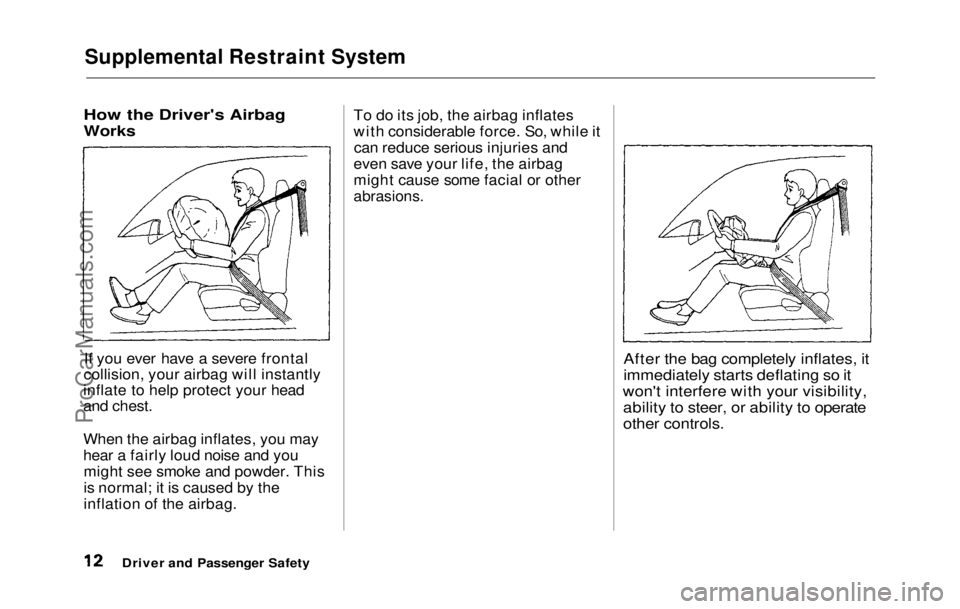1992 HONDA PRELUDE airbag
[x] Cancel search: airbagPage 4 of 225

Driver and Passenger Safety
This section gives you important
information about occupant protection. It shows how to use seat
belts properly. It explains the Supplemental Restraint System.
And it gives useful information about how to protect infants and
children in your car. Your Occupant Protection
System........................................ 4
The Seat Belt System
and How It Works.................... 5
Why Wear Seat Belts................... 5 Important Safety Reminders..... 5
Seat Belt System Components... 6
Lap/Shoulder Belt........................ 6
Wearing Seat Belts Properly...... 6
Wearing a Lap/Shoulder
Belt ............................................. 7
Advice for Pregnant Women..... 8 Seat Belt Maintenance................ 9
Supplemental Restraint System.. 10 Important Safety Reminder..... 11
How the Driver's Airbag
Works........................................ 12
How the Passenger's Airbag
Works........................................ 13
How the SRS Indicator Light
Works ...................................... 14
System Service.......................... .
14
System Service Precautions..... 15
Additional Safety Information .... 16 Seat-back Position..................... 16
Door Locks.................................. 16 Storing Cargo Safely ................
17
Driving wit
h
Pets....................... 17
Child Safety..................................... 18
Where Should Children Sit?..... 18
Important Safety Reminders... 19
General Guidelines
for Restraining Children Under 18 kg (40 Ibs)............... 19
Restraining an Infant Who Weighs Less Than 9 kg (20 Ibs)......... 20
Restraining a Child Who Weighs Between
9 and 18 kg (20 and 40 Ibs).... 20
Using Child Restraints with Tethers............................
21
Using a
Seat Belt
Locking Clip............................ 22
Restraining a Child Who Weigh
s
Over 1 8
kg (40 Ibs)..................
23
Storing a
Chil
d Seat...................
23
Alcohol and Drugs..........................
24
Carbon Monoxid
e
Hazard ............
25
Reporting Safet
y
Defects
(US Cars)......................................
26
Safety Labels .................................
27
Driver an d
Passenger SafetyProCarManuals.comMain Menu s t
Page 5 of 225

Your Occupant Protection System
Your Honda is equipped with seat
belts and other features that work
together to protect you and your
passengers during a crash.
Seat belts are the most important
part of your occupant protection
system. When worn properly, seat
belts can reduce the chance of serious injury or death in a crash.
For added protection during a
severe frontal collision, all Preludes
sold in the U.S. and the SR and SR
4WS models in Canada have a Supplemental Restraint System
(SRS) with a driver's airbag. The Si
4WS model sold in the U.S also hasa passenger's airbag. Two indicator lights are also part
of your safety system. One reminds
you to make sure you and your passengers wear your seat belts.
The other alerts you to a possible
problem with your supplemental
restraint system (see page 14).
The seats, head restraints, and door
locks also play a role in occupant safety. For example, reclining the
seat back can decrease the effec-
tiveness of your seat belt. Head
restraints can help protect your neck and head, especially during
rear-end impacts. Door locks help
keep your doors from being acciden-
tally opened during a crash. To get the maximum protection
from your occupant protection
system, check the following before
you drive away:
Everyone in the car is wearing a
seat belt properly (see page 6).
Both doors are closed and locked
(see page 16).
Seat backs are upright (see page
16).
There are no loose items that
could be thrown around and hurt
someone during a crash or
sudden stop (see page 17).
By following these guidelines, you
can reduce injuries to yourself and
your passengers in many crash
situations. Remember, however,
that no safety system can prevent all injuries or deaths that can occur
in severe crashes.
Driver and Passenger SafetyProCarManuals.comMain Menu Table of Contents s t
Page 11 of 225

Supplemental Restraint System
All Preludes sold in the U.S. are equipped with a Supplemental
Restraint System (SRS). (This
system also comes on the SR and SR 4WS models in Canada.)
The supplemental restraint system
includes an airbag to help protect
your head and chest during a se-
vere frontal collision. This system does not replace your seat belt. It
supplements, or adds to, the protec- tion offered by your seat belt.
The system on the Si 4WS model in
the U.S also includes a front
passenger's airbag.
The main components in your SRS
are:
An airbag in the steering wheel
for the driver.
(On Si 4WS model)
An airbag in the dashboard for the passenger.
A diagnostic system that continu- ally monitors the sensors, control
unit, airbag activators and all
related wiring while the ignition
is ON
(II).
Driver and Passenger Safety
Not wearing a seat belt in-
creases the chance of serious injury or death in a crash, even
if you have an airbag.
Be sure you and your passen-
gers always wear seat belts
and wear them properly. INDICATOR
CONTROL
UNITPASSENGER'S
AIRBAG
DRIVER'S
AIRBAG
SENSORSProCarManuals.comMain Menu Table of Contents s t
Page 12 of 225

Supplemental Restraint System
An indicator light to warn you of a possible problem with the
system.
Emergency power backup in case
your car's electrical system is
disconnected in a crash.
Important Safety Reminder
Even with an airbag, you need to
wear a seat belt. The reasons are: Airbags only inflate in severe
frontal collisions. They offer no
protection in rear impacts, side
impacts, rollovers, or moderate
frontal collisions. An airbag inflates and deflates
very quickly. It cannot protect
you during any additional
impacts that can occur during a
crash.
A seat belt helps keep you in the
proper position when an airbag
inflates. An airbag opens with
considerable force, and it can
hurt you if you are not in the proper position.
Driver and Passenger Safety
Frontal collislon rangeProCarManuals.comMain Menu Table of Contents s t
Page 13 of 225

Supplemental Restraint System
How the Driver's Airbag
Works
If yo
u ever have a severe frontal
collision, your airbag will instantly
inflate to help protect your head
and chest.
When the airbag inflates, you may
hear a fairly loud noise and you
might see smoke and powder. This
is normal; it is caused by the
inflation of the airbag. To do its job, the airbag inflates
with considerable force. So, while it
can reduce serious injuries and
even save your life, the airbag
might cause some facial or other
abrasions.
After the bag completely inflates, it
immediately starts deflating so it
won't interfere with your visibility,
ability to steer, or ability to operate
other controls.
Driver and Passenger SafetyProCarManuals.comMain Menu Table of Contents s t
Page 14 of 225

Supplemental Restraint System
The airbag is stored in the center
of the steering wheel. For your safety, do not attach any items to
the steering wheel. They could interfere with the proper operation
of the airbag. Or, if the airbag
inflates, they could be propelled
inside the car and hurt someone.
How the Passenger's Airbag
Works
If you ever have a severe frontal
collision, the passenger's airbag
will inflate at the same time as the
driver's airbag. This airbag is quite large and
inflates with considerable force. It
can seriously hurt an adult who is
not in the proper position and
wearing the seat belt properly. The
bag's force could also hurt a small child who is not properly restrained
in a child seat.
Because of the airbag, we strongly
recommend that you do not put an
infant seat in the front passenger's
seat. If the airbag inflates, it can
dislodge the infant seat and
seriously injure the infant.
CONTINUED
Driver and Passenger SafetyProCarManuals.comMain Menu Table of Contents s t
Page 15 of 225

Supplemental Restraint System
The passenger's airbag is stored
near the top of the dashboard,
under a lid marked SRS. Do not
place any objects on top of this lid. If the airbag inflates, those objects
can be propelled inside the car and possibly hurt someone.
How the SRS
Indicator Light Works
The purpose of the SRS light on
your instrument panel is to alert
you of a potential problem with
your supplemental restraint system.
Have the system checked if:
The light does not come on when
you turn the ignition ON (II). The light stays on after the
engine starts.
The light comes on or flashes
while you are driving.
System Service
Your supplemental restraint
system is virtually maintenance-
free. There are no parts you can
safely service.
You must have the system serviced
by an authorized Honda dealer in the following situations: If your airbag ever inflates. The
bag must be replaced. Do not try
to remove or discard the airbag
by yourself. This must be done by a Honda dealer.
If the SRS indicator light alerts
you of a problem. Have the
supplemental restraint system
checked as soon as possible.
Otherwise, your airbag might not
inflate when you need it. When the car is ten years old, get
the system inspected. The
production date is on the driver's
door jamb for your convenience.
Driver and Passenger Safety
SRS
ProCarManuals.comMain Menu Table of Contents s t
Page 16 of 225

Supplemental Restraint System
System Service Precautions
Do not modify your steering wheel
or any other part of the supple-
mental restraint system. Modifica-
tions could make the system inef-
fective.
Do not tamper with the system
components or wiring. This could cause the airbag to inflate inadver-
tently, possibly injuring someone
very seriously.
Tell anyone who works on your car
that you have a supplemental
restraint system. Failure to follow
the procedures and precautions in
the official Honda service manualcould result in personal injury or
damage to the system.
Scrapping an entire car that has an
uninflated airbag can be dangerous.
Get assistance from a Honda dealer
if your car must be scrapped.
If you sell your car, please be sure
to tell the new owner that the car
has a supplemental restraint sys-
tem. Alert them to the information
and precautions in this part of the
owner's manual.
Driver and Passenger SafetyProCarManuals.comMain Menu Table of Contents s t